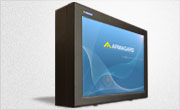Roadside America – Online archive shows the history of the American Billboard
Posted by: Richard Williams | Posted on: | 0 Comments
The billboard has long been part of American culture. From iconic signs along iconic highways like Route 66 to modern outdoor digital signage displays causing angst in local counties over fears of roadside distraction. However, the billboard is as ingrained in American culture as the motor car itself is.
Now, more than 27,000 images of billboards and outdoor advertisements have been made available from Duke University Libraries, North Carolina, bringing together a vast collection of outdoor advertisements spanning over the last century.
Featuring national campaigns from well-known brands that will spark nostalgia to those who’ve travelled across America during the past decades, to small local campaigns from mom and pop stores. The archive proves an interesting cultural look at American advertising over the last century and demonstrates the continual effectiveness of outdoor advertising.
Times are changing and the traditional billboard is increasingly being usurped by outdoor digital signage.
Outdoor digital signage provides many advantages over traditional billboard imagery. Firstly, with remote uploading, digital signage doesn’t need technicians to travel to remote destinations to paste up new content—something that is both cost saving and kinder to the environment. True, outdoor digital signage requires power to run, but with power consumption for screens on the decline, and with static signs requiring powered lighting to illuminate them at night, the power consumption of digital signage is not as large as first imagined.
Another advantage for advertisers using outdoor digital signage is its visual appeal. Moving images and high definition screens provide a far more eye-catching method of relaying content. However, some argue that this engaging quality of outdoor digital is cause for concern, with protest groups and counties banning digital signage over fears it can distract drivers—although in Europe where giant screens are placed along sides some of the busiest and fastest stretches of road, no increase in accidents have ever been reported.
Post shortlink:
Popular Products
LCD Enclosure
Need armor for your LCD/LED screen(s)? Outdoors or inside the versatile LCD enclosure protects against thieves, vandals & the weather. Installation idea: NFL stadiums.
Outdoor Digital Signage
Exclusive 46” outdoor screen protection. Dubbed the ‘Totem’, due to its distinct design, it repels damage threats, but attracts audiences. Installation idea: Drive-thru restaurants.
Portrait Flat Panel Enclosure
Safeguard your eye-level advertising display screen(s), indoors or outdoors. Completely customizable, add exciting features like touch screen technology. Installation idea: Restaurant frontages.
Indoor Digital Signage
Popular purchase for retail outlets! Great for ‘point of sale’ persuasion, boost your brand with static & motion advertising from a single unit! Installation idea: Mall of America.




